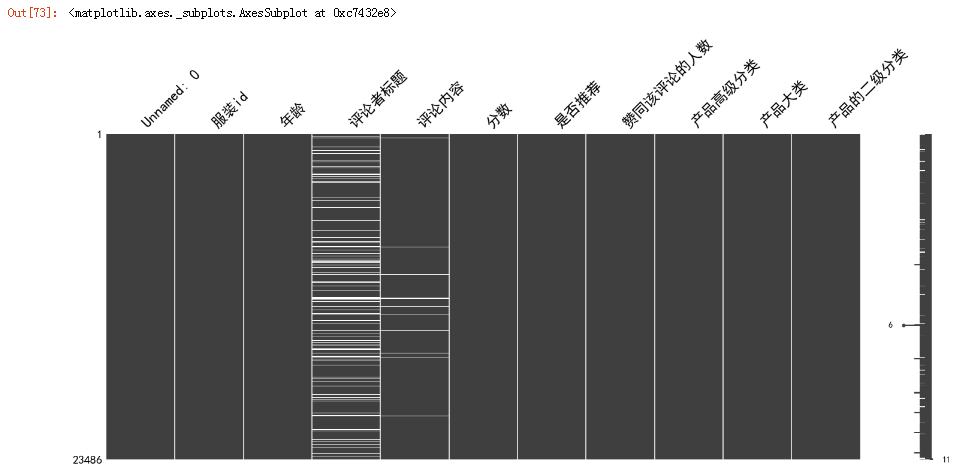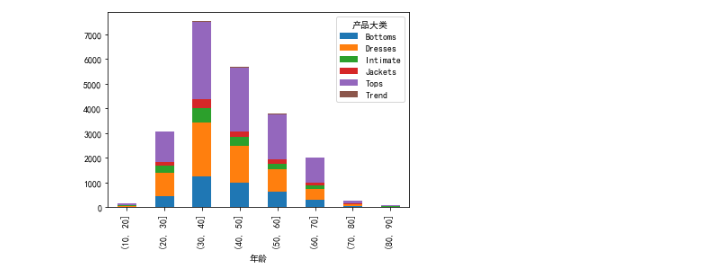#auther bioamin #nlp of 电商评论 #-*- conding = utf-8 -*- import numpy as np import pandas as pd #画图的包 import matplotlib.pyplot as plt import seaborn as sns plt.rcParams['font.sans-serif']=['SimHei'] plt.rcParams['axes.unicode_minus']=False #忽略警告 import warnings warnings.filterwarnings("ignore") import missingno new_cloumname = {"Clothing ID":"服装id","Age":"年龄","Title":"评论者标题", "Review Text":"评论内容","Rating":"分数","Recommended IND":"是否推荐", "Positive Feedback Count":"赞同该评论的人数", "Division Name":"产品高级分类", "Department Name":"产品大类", "Class Name":"产品的二级分类"} #读取数据并且利用 rename() 函数输入字典替换列名 df = pd.read_csv("Comment.csv") df=df.rename(columns = new_cloumname) df.head()

missingno.matrix(df,fontsize = 25)

col = "评论内容" #删除缺失值 df = df.dropna(subset=[col]) missingno.matrix(df,fontsize = 25)

#增加新特征 df["评论字数"]=df["评论内容"].astype(str).apply(len) df.head()

#评分和字数 数据可视化 #先sns.FacetGrid画出轮廓 #然后用map填充内容 g = sns.FacetGrid(data = df,col = "分数") g.map(plt.hist,"评论字数",bins=10) plt.show() #评分越高,评论字数越多

#评分与字数关系的可视化2 sns.pointplot(x="分数",y="评论字数",data=df) plt.show() #评分为3的人最喜欢写评论

#找出与服装评分相关性最强的10个变量 k=10 #df.corr() 相关系数的计算可以调用pearson方法或kendell方法或spearman方法,默认使用pearson方法。 #round() 四舍五入,保留2位小数 corr = round(df.corr(),2) corr

#panadas.Dataframe # pd.DataFrame.nlargest(n ,cloumns,keep="first") get the row of a DataFrame by the largest values of columns cols = corr.nlargest(k,'分数') cols

cols = corr.nlargest(k,'分数')["分数"].index cm = round(df[cols].corr(),2) #np.zeros_like() Return an array of zeros with the same shape and type as a given array. # mask = np.zeros_like(cm,dtype = np.bool) mask[np.triu_indices_from(mask)] = True plt.figure(figsize = (8,8)) cmap = sns.diverging_palette(220,10,as_cmap = True) sns.heatmap(cm,mask = mask,cmap = cmap ,center = 0,annot = True ,cbar_kws = {"shrink":.5})

df.groupby(["分数",pd.cut(df["年龄"],np.arange(0,100,10))]).size().unstack(0).plot.bar(stacked = True) plt.show()

#产品类别与年龄 df.groupby(["产品大类",pd.cut(df["年龄"],np.arange(0,100,10))]).size().unstack(0).plot.bar(stacked = True) plt.show() 30-40 40-50是购物的主要年龄段 在各个产品类别中,top在各个年龄段的销量都不错
